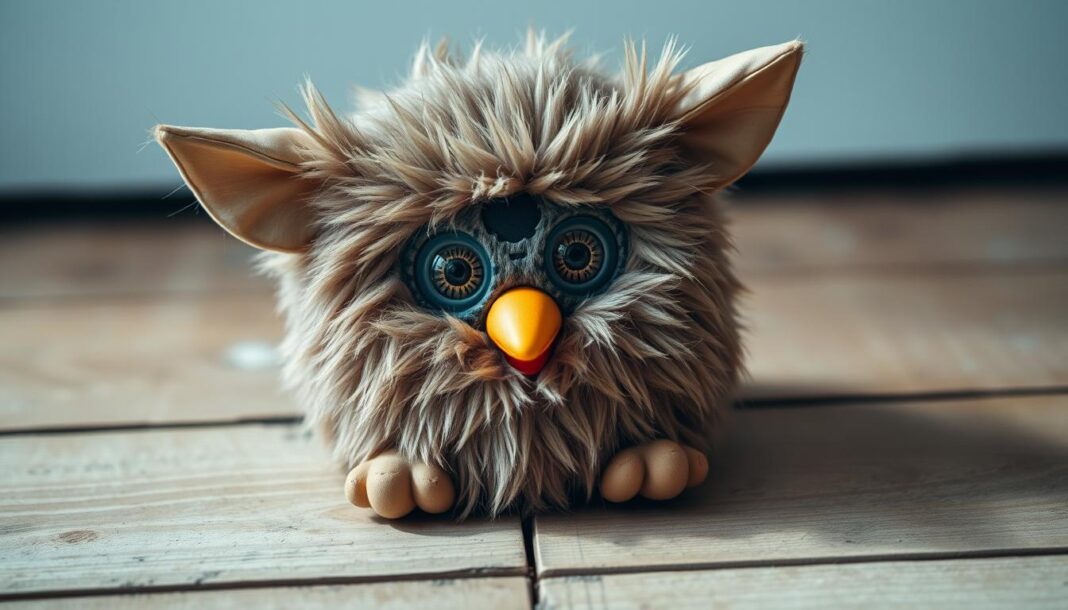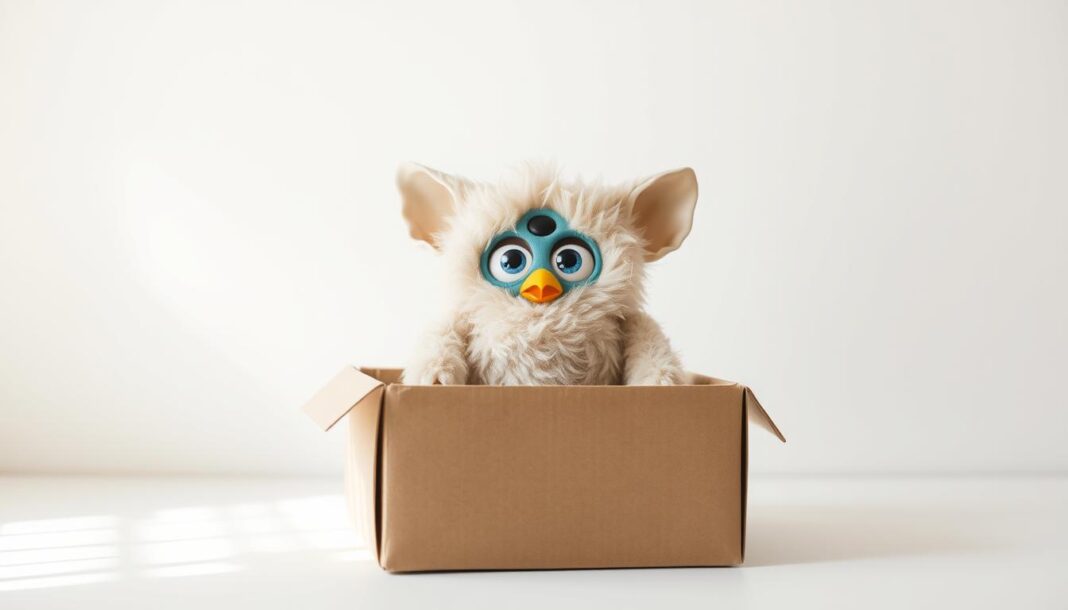For over 25 years, these interactive toys have captured hearts worldwide. Originally launched in 1998, they quickly became a cultural phenomenon, selling over 40 million units. Their ability to “learn” languages and respond to touch made them stand out in the toy industry.
This guide helps both new and seasoned collectors navigate the market. You’ll learn about different generations, rare variants, and current trends. The recent 2023 relaunch introduced voice-activated features and expanded responses, adding fresh appeal.
Available in 14 languages, these collectibles have global appeal. Whether you’re hunting for vintage pieces or exploring modern releases, understanding their history and value is key. We’ll cover everything from early models to current market values.
Key Takeaways
- Over 40 million units sold during the original production run
- Recent 2023 models feature advanced voice recognition
- Available in 14 languages for worldwide collectors
- Guide covers history, generations, and investment potential
- Includes a breakdown of rare and high-value variants
The Fascinating History of Furby Dolls
Few toys have sparked as much intrigue as the 1998 release of this electronic sensation. Designed by David Hampton and Caleb Chung, it redefined interactive play with its ability to learn languages and respond to touch. Over the years, it evolved from a toy into a cultural icon.
Origins and Creation
The original furby launched under Tiger Electronics, retailing at $35. Its groundbreaking AI mimicked language acquisition, shifting from “Furbish” to English over time. Engineers disproved NSA concerns about recording capabilities after a 1999 ban in the United States.
Initial Popularity and Cultural Impact
Demand skyrocketed during the 1998 holidays, with resale prices hitting $300+. By 1999, 14 million units were sold worldwide. McDonald’s UK Happy Meal promotions in 2000 cemented its status as a phenomenon.
| Year | Sales (Millions) | Key Event |
|---|---|---|
| 1998 | 1.8 | Initial launch |
| 1999 | 14.0 | NSA ban lifted |
| 2000 | N/A | McDonald’s partnership |
Twenty-five years later, its legacy endures through re-releases and collector communities. The blend of nostalgia and innovation keeps it relevant today.
Generations and Types of Furby Dolls
From mechanical beginnings to voice-activated marvels, these collectibles have transformed dramatically. Each generation introduced unique features, creating distinct eras for enthusiasts and collectors.
First Generation (1998–2002)
The original model used infrared (IR) communication and a fictional language called Furbish. It gradually learned English, captivating users with its playful interactions. Over 14 million units sold in 1999 alone.
Second Generation (2005–2007)
Emoto-Tronic technology added voice recognition and expressive movements. These toys could dance and respond to touch more fluidly. Limited editions like the Star Wars Furbacca became instant hits.
Third Generation (2012–2015)
LCD eyes and mobile app integration marked this era. The app allowed feeding and games, though services are now discontinued. Smaller versions, like Furby Babies, appealed to younger fans.
Fourth and Fifth Generations (2016–Present)
Bluetooth and color LCD eyes debuted in 2016. The 2023 model removed apps but added voice activation and retro-inspired designs. Bundled accessories revitalized collector interest.
Rare variants, such as the Crystal series, remain highly sought after. For a deeper dive into rare variants, explore our dedicated guide.
Key Features That Define Furby Dolls
Innovative technology has always been at the core of these beloved playthings. Their defining features—interactive responses, language learning, and striking designs—set them apart in the collectibles market. Let’s explore what makes each generation unique.
Interactive Capabilities
Early models packed 40+ sensors for motion, touch, and sound detection. Tilt or shake one, and it giggled or protested. The 2023 versions refined this with precision accelerometers for smoother reactions.
Physical interactions drive personality development. Pet its back, and it purrs. Cover its eyes, and it might pretend to sleep. These quirks create emotional bonds with users.
Language and Learning
Originally, they “spoke” Furbish but gradually mixed in English phrases. Newer models expanded this with 5 voice recognition modes and 600+ responses. Say “hello,” and it replies with a joke or song.
Design and Aesthetics
LCD eyes evolved from monochrome pixels to full-color animations. Limited editions like the Crystal series added glitter shells, while 2023 models mimic retro designs. Accessories—combs, necklaces—let fans customize their collectibles.
Whether it’s the nostalgic charm of vintage pieces or the tech upgrades of modern releases, these features ensure lasting appeal.
Why Furby Dolls Remain Popular Today
Decades after their debut, these interactive companions continue to captivate fans globally. Their blend of nostalgia, innovation, and community-driven appeal sustains relevance in a competitive toy market. Let’s explore the factors behind their lasting success.
Nostalgia Factor
For many, these toys evoke cherished childhood memories. The 2022 BBC coverage of their 25th anniversary highlighted how millennials now share them with their own kids, creating multigenerational bonds. Limited re-releases, like the 2023 retro models, tap into this emotional connection.
Cultural recognition amplifies their status. Museum exhibitions and viral social media trends celebrate their impact as 90s icons. Their role as a friend to lonely children during the original boom still resonates today.
Collectibility and Community
An active secondary market fuels demand, with rare variants fetching premium prices. Online forums and trading groups thrive, where enthusiasts discuss restoration tips and hunt for collaborations like Star Wars or Gremlins editions.
Educational value adds another layer. Parents appreciate how they encourage language development and responsibility in younger users. For collectors, the hunt for mint-condition pieces or similar interactive toys becomes a rewarding hobby.
- Global reach: Sold in 14 languages, uniting fans worldwide
- Innovation meets tradition: Voice-activated updates honor original designs
- Cultural milestones: Featured in media and museum displays
Understanding Rarity and Collectibility
Collectors worldwide prize certain models for their scarcity and unique traits. Limited production runs, regional exclusives, and special collaborations create tiers of value in the secondary market. The 1998 “Peacock” variant, for example, now commands $500+ in mint condition.
Limited Editions and Special Releases
These standouts dominate collector wishlists:
- Shelby (2005): Only 10,000 made, with metallic purple colors
- Gizmo (2016): Gremlins crossover with white fur and unique voice lines
- Furbacca (2017): Star Wars edition featuring Chewbacca sounds
The 2014 Crystal series saw values jump 300% after discontinuation. European-exclusive Furby Babies also attract premium bids from U.S. collectors.
Factors That Increase Value
Original packaging adds 40-60% to resale values. Authentication markers vary by generation:
- 1998-2002: Serial tags under battery covers
- 2012-2015: Holographic stickers on feet
Neon colors generally outperform pastels in resale markets. Complete sets with accessories (combs, certificates) fetch the highest prices.
Pricing Guide: What to Expect When Buying
Navigating the collectibles market requires understanding pricing trends and value factors. Whether you seek vintage gems or modern releases, prices vary based on rarity, condition, and demand. This guide breaks down key information to help you make informed decisions.
Vintage vs. Modern Models
First-generation pieces (1998–2002) command the highest price, especially sealed units. Mint-condition Peacock editions sell for $1,200+, while used models average $50–$200. Modern releases (2016–2023) retail for $65–$80 but lack long-term appreciation potential.
Key differences:
- Vintage: Higher resale value, but parts may need restoration.
- Modern: Affordable with warranty support, but limited collectibility.
Where to Find the Best Deals
Trusted stores include eBay, Mercari, and specialty toy auctions. Big-box retailers like Target offer new releases, while niche shops stock rare variants. Seasonal sale events (Black Friday, post-holiday) often feature discounts.
| Generation | Price Range | Best Marketplace |
|---|---|---|
| 1998–2002 | $50–$1,200 | eBay Auctions |
| 2012–2015 | $30–$300 | Mercari |
| 2023 | $65–$80 | Retailers |
Pro tip: Bookmark rare models listings to track price drops. Authenticity checks (serial tags, holograms) prevent overpaying for reproductions.
Tips for Buying Furby Dolls
Smart buyers know that authentication is key when adding to their collection. The market contains both genuine treasures and clever reproductions. Follow these professional guidelines to make informed purchases and avoid common pitfalls.
Verifying Authenticity
Check serial numbers in these locations by generation:
- 1998-2002: Under battery cover
- 2005-2007: Right ear tag
- 2012+: Foot holograms
Examine battery compartments for corrosion or replacement parts. Hasbro’s certification program provides documentation for high-value purchases. These details help confirm you’re getting original electronics.
Assessing Condition
Original packaging increases value by 40-60%. Look for:
- Intact blister packs
- Matching SKU numbers
- Uncut security ties
For loose items, test all interactive features. The games and voice responses should work flawlessly. Preserve electronic components by storing in climate-controlled spaces.
Where to Purchase
These marketplaces offer the best action for collectors:
| Platform | Best For | Scam Prevention |
|---|---|---|
| eBay | Vintage pieces | Request video verification |
| Mercari | Modern releases | Check seller ratings |
| Specialty auctions | Rare models | Authentication guarantees |
For limited editions like the rare models, consider certified dealers. Their expertise in the art of collectibles ensures you get authentic items.
The Future of Furby Dolls in Collecting
From physical to digital, the next chapter for these toys is already unfolding. The 2023 Furblets release hints at miniaturization trends, while rumors swirl about NFT-integrated characters. Hasbro’s digital strategy may blend physical collectibles with virtual pet apps.
Upcoming film adaptations could expand the franchise into action figures and trading cards. Meanwhile, AI advancements may enable deeper personality customization. Collector demographics shift as Gen Z joins nostalgic millennials.
Preservation poses challenges—early electronic components degrade faster than plastic. Yet, their cultural footprint ensures lasting relevance. For those tracking rare models, the future holds both risks and exciting potential.

